|
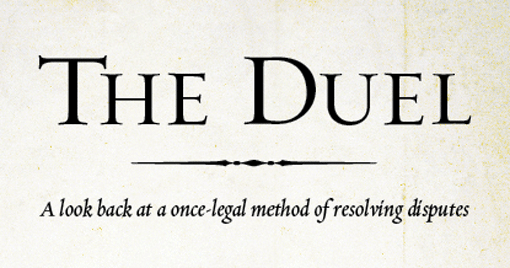
By Jennie C. Meade
Duel. The word conjures vivid images of elegant
swordsmen in contest, or armor-clad knights astride
destriers defending a lady’s honor. Or
perhaps a rendezvous at first light, pistols
at the ready. Romantic and uncomplicated to the
contemporary eye, the reality of duelling was
neither so romantic nor
so simple. It operated under a complex set of
rules and customs, legal and social, which determined
why, how, and between whom duels were to be fought.
Duelling for hundreds of years was a deep-rooted
practice in European and American culture, one
which finally died with changing times yet thrives
today in sport and pageantry to remind us of
days when combat mano a mano resolved individual
disputes.

|
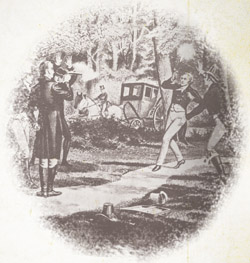
The famous Hamilton-Burr
duel of 1804, showing former
Secretary of the Treasury Alexander
Hamilton’s shot into the air,
and Vice President Aaron Burr’s
fire at Hamilton.
|
Accounts differ as to whether duelling existed
in ancient Greece and Rome, but certainly it
was a fixture in the barbarian Germanic tribes,
later spreading through Europe and America. The
duel is defined as a prearranged combat between
two persons, fought with deadly weapons according
to an accepted code of procedure to settle a
private quarrel. Thus the duel is distinguished
from a brawl (which is not prearranged or fought
according to rules), a war (a prolonged affair
with many combatants), and a tournament (which
although it operated by the same rules, was a
test of skill that decided no private dispute).
The customary duelling weapon was the sword,
superseded in the 19th century by the pistol.
The duel evolved
from its origins as a legal method of resolving
disputes into an extrajudicial avenue for settling
private matters that could not be regulated by
law: matters of honor and insult. Coincident
with the formulation of code, which provided
procedural guidance in conducting a duel, were
attempts by church and state to curtail the practice.
The fascination of duelling may have its roots
in the curious dichotomy of a prevalent and culturally
accepted yet illegal pursuit, governed by a “code.” Its
persistence as a fixture in so many cultures
speaks of its universal appeal as the expression
of a visceral human response that managed to
survive, in assorted manifestations, for many
centuries. But the notion of duelling as
an atavistic reaction alone falls short of the
mark, since
it looks past the reality that duels were fought
chiefly
by one segment of society, its aristocrats. It
is this social ingredient that defines the duel
as an institution and has fixed its status as
a legal conundrum.
The Judicial Duel
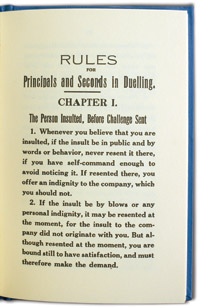
The Code of Honor (1858). Former South Carolina Governor John Lyde Wilson composed
a set of “rules for the government of principals and seconds in duelling,” a
best-selling document which gentlemen kept close at hand.
|

|
Although condemnation by governmental and ecclesiastical
authorities progressively increased, duelling
originally was a legal means of deciding disputes
between two people. The “judicial duel” or
combat was based on religious belief: that God
would protect the party in the right by allowing
him to win. Although many combats were arranged
to decide criminal matters, combat also could
serve as a means for resolving civil disagreements
such as disputes over property. Women, the infirm,
very young, and very old men were not required
to enter combat but could engage champions on
their behalf. The judicial duel was a ceremonial
affair presided over by royalty who proclaimed
the victor.
The earliest known law that governed the judicial
duel
is found in the Burgundian Code, an early East
Germanic barbarian code promulgated in the
late 5th and early 6th centuries. The date
of legal establishment of the trial by combat
traditionally is stated as the year 501.
Eventually trial by combat was permitted
only in cases of serious crimes, such as
murder and treason. The right to choose trial
by combat existed in England until the early
19th century, where the last claim for combat
occurred in 1817. Although the court granted
this claim, circumstances did not permit
the encounter, and promptly in 1819 Parliament
abolished the right to trial by combat.
The Duel of Chivalry
The duel of chivalry evolved from the judicial
duel, and co-existed with it for several hundred
years. Scholars generally agree that knighthood
originated in the 10th century, and duels of
chivalry date from that time. These were events
of great ceremony: two knights on horseback with
lances engaged in combat to decide questions
of law, property, or honor. The duel of chivalry
is distinguished from the tournament, a demonstration
of a knight’s skill. These could be as
bloody as a duel. In fact, the church was opposed
to tournaments due to the mortality rate of the
participants, and the Council of Reims of 1148
prohibited Christian burial for the casualties
of such events.
Duels of chivalry faded around the middle of
the 16th century, giving way to the duel of honor.
The Duel of Honor and the Code Duello

|
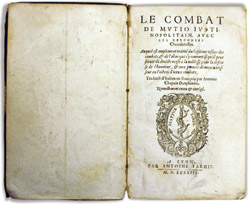
Le
Combat de Mutio Iustinopolitain (1583). France
drew its duelling tradition from Italy
and its celebrated masters of the art.
Translated from the Italian into French,
this early work outlined the “legitimate
use of combats” as well as abuse
of the practice.
|
The duel of honor is the duel most familiar
to us. Beginning around mid-16th century, it
lingered into the 20th century in France, Germany,
and the United States. It originated in an era
where courtesy and respect between individuals
were of supreme moment. An insult—especially
to another’s integrity, courage, or to
the honor of his lady—could provoke a challenge.
Failing an apology, the potential combatants
proceeded to the duel, aided by a duelling code,
which set
the procedural requirements. Duels generally
were fought between noblemen, but duellists at
least were required to be of equal social status;
it was considered improper for persons of differing
ranks to fight duels against each other.
Although today this style of extrajudicial personal
combat may appear primitive, the duel of honor
represents a giant step toward civilizing human
behavior by curtailing the proliferation of the
lethal surprise attacks common in that era. The
duel of honor came to be governed by strict codes
of regulations, which multiplied in Europe during
the 16th through 19th centuries.
The code
duello, or duelling code, provided rules
for engaging and conducting duels of honor. It
was drafted to ensure order, fairness, and opportunity
for the duel to be averted in honorable fashion.
The earliest known code duello was the Renaissance-era
Flos Duellatorum in Armis of Fiore dei Liberi
(Italy, circa 1410). The most famous code, and
the most important for English-speaking countries,
was the Irish Code Duello, or “the
26 commandments.” Gentlemen
delegates drew the code to regulate—legally—affairs
of honor conducted outside the law. To avoid
claims of ignorance of the rules, gentlemen were
required to keep a copy in their pistol cases.
This code contemplated the use of pistols but
also provided for swords. American duellists
relied either on the Irish Code
Duello or the
American version authored in 1838 by lawyer,
duellist, and former Governor John Lyde Wilson
of South Carolina (one of the foremost duelling
states
in the Union).
Participants
in Duels of Honor
Duellists in
Europe were nobles, or men who carried arms by
reason of their profession, usually soldiers.
In America where no titled aristocracy existed,
duellists mostly came from the ranks of lawyers,
government office holders, and sundry gentlemen,
groups with much at stake in a duel of honor.
Ironically, the first American duel was fought
between two servants in New England (Massachusetts,
1621), where duelling was far less common than
in the South.
It was not unusual
for a nobleman or gentleman to fight a number
of duels in his lifetime. Records are scarce
and anecdotal, and probably underreport the numbers
of duels fought by particular individuals. But
reports chronicle scores of men with extraordinary
numbers of duels to their credit. In France during
the reign of Louis XIII (1610-1643), one ardent
duellist was credited with killing 72 men by
the age of 30. American President Andrew Jackson
(1767-1845) purportedly fought more than 100
duels during his life. And even if a man was
not prone to duelling, as a gentleman his honor
(and in America, often his livelihood) would
suffer blemish
if he mishandled a challenge.
Legal and Ecclesiastical Opposition to Duelling
There was no dearth of opposition to all forms
of duelling by either state or church authorities,
beginning as early as the 11th century. The 1041
Truce of God and Louis VII’s 1167 prohibition
chipped away at trial by combat, and the 1148
Council of Reims denied Christian burial to tournament
casualties. When the Council of Trent (1545-1563)
in its 19th canon prohibited princes from providing
a closed field for combat on penalty of excommunication,
and condemned duellists, accomplices, and spectators
to excommunication, a severe blow was dealt to
all forms of duelling in France—in theory,
that is. France never recognized the council’s
decrees, in great part due to the 19th canon.
French clergy continued the attack on duelling,
building support among ecclesiastics, and Church
condemnation of the practice continued vigorously
throughout the 16th and 17th centuries.
|

|
In France, anti-duelling measures were promulgated
with increasing frequency. Henri IV (reigned
1589-1610) and Louis XIII (reigned 1610-1643)
issued anti-duelling edicts; during the reign
of Louis XIV (1643-1715) at least 10 edicts
aimed at curtailing duelling were issued,
until he found it necessary to issue the
Edit des Duels (1679), which ordered death
and confiscation of property for duellists
and their accomplices. However, the King
was inconsistent in his support of his own
laws, and the practice of duelling continued
much as it had before.
In common law countries duelling always had
been illegal, the transgression punished according
to the offense committed under the common law.
A duellist could be charged with crimes ranging
from assault to murder. The common law approach
garnered more prosecutions and convictions
than the continental European approach, which
targeted duelling as a separate offense.
In America, duelling was a tradition of the
Southern gentry, which intensified in the early
19th century. Most early anti-duelling legislation
sought to deter duelling by barring duellists
from public office. Although enactment of anti-duelling
legislation lagged, eventually all states and
the District of Columbia (1839) passed legislation
prohibiting duelling. American duelling did
not enjoy the degree of popular favor it did
in Europe, perhaps because although Southerners
were fond of the institution, the Northern
states never internalized it as part of their
culture. Many writers have linked the decline
of duelling in America to the end of the Civil
War, consistent with Confederate defeat and
the universal tendency of duelling to ebb in
the wake of wartime. Others have cited the
efficacy of ever more stringent duelling laws.
Sporadic episodes continued into the 20th century,
yet duelling had passed its zenith in this
country and ceased to be a powerful social
custom.
These illustrations are emblematic of widespread
attempts by the law and the church to eliminate
duelling. Yet duelling continued. Issues of
honor over which duels were fought were mostly
not justiciable in courts of law. For those
issues that were, duellists were unwilling
to submit to the courts, preferring private
resolution. The system of honor to which duellists
subscribed operated outside the civil and criminal
justice systems, as well as the church. The
dominance of nobility in Europe, and of lawyers,
politicians, and gentry in America, was undeniable,
since in many cases these very individuals
were the transgressors as well as the police.
Often, these very individuals intentionally
drafted laws to provide avenues for avoidance
of penalties.
The Decline of Duelling
It is uncertain to what degree worldwide anti-duelling
efforts contributed to the decline of duelling.
Yet it is clear that duelling as a robust social
phenomenon of the aristocracy mastered most legal
attempts to contain it. Indeed, its virtual disappearance
by the 20th century as a valid method of deciding
disputes suggests a link to the widespread democratization
of the world’s societies rather than a
sudden or even gradual capitulation to the law.
What remains today, apart from isolated encounters
in France and Germany, are stylized derivative
games such as fencing and jousting. They remind
us how disputes often were settled, outside court,
before the 20th century.
—Jennie C. Meade is the rare books librarian
at the Jacob Burns
Law Library. An expanded version of “The
Duel,” featuring works
on duelling from the Law Library’s collection,
is a permanent online exhibition at the library’s
Special Collections Web site, viewable at www.law.gwu.edu/Burns/rarebooks/exhibits/duel.htm.

|
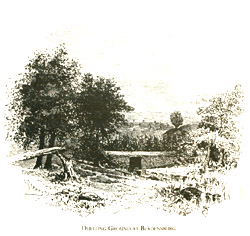
Dueling
Ground at Bladensburg.
|
Famous Duels
Hamilton-Burr (1804)
The 1804 Hamilton-Burr duel is recognized
as the most famous and distressing duel
in American history. The “interview
at Weehawken” matched Vice President/lawyer
Aaron Burr against the popular former Secretary
of the Treasury/lawyer Alexander Hamilton.
The two men were not congenial personally;
combined with political differences of
long standing they were led inexorably
to duel after an exchange of letters initiated
by Burr. Burr took issue with Hamilton’s
purported use of the word “despicable” in
describing his opinion of Burr. Hamilton’s
cocksure yet evasive response vexed Burr
even more, and soon a challenge was issued
by Burr’s second, Van Ness, and accepted
by Hamilton’s second, Pendleton.
Hamilton’s last writing before the
duel stated his opposition to duelling
but his inability to decline this duel,
citing reasons of honor and politics.
The popular analysis of the outcome was
that Burr was a cold-blooded killer. Public
regard for Hamilton was intense; Burr was
charged with murder in New Jersey and began
a steady political, professional, and personal
decline, dying penniless in 1836.
Jackson-Dickinson (1806)
Future President and lawyer Andrew Jackson
and Charles Dickinson, a prominent Maryland
lawyer and horse breeder, also entertained
a longstanding antipathy, sparked by a bet
on a horse race. Both were sportsmen and
crack shots. When Dickinson slandered Jackson’s
wife, a duel was inevitable, and both intended
to kill the other. Dickinson fired first
at the signal. Jackson took the bullet in
the chest, then stood firm and aimed, but
his pistol stopped at half-cock. He adjusted
his pistol, aimed again, and fired. Dickinson’s
wound was mortal. Jackson’s own wound
was serious, necessitating a prolonged recovery.
This duel, although it did not prevent Jackson
from being elected President, damaged his
reputation,
as he was considered to have murdered Dickinson
in cold blood.
Other
Famous Duels
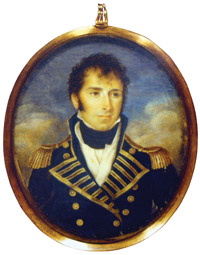
The dashing Commodore Stephen Decatur, mortally wounded in a duel at
Bladensburg,
died at his home across from the White House
in 1820. This medallion of Decatur was reproduced courtesy of the U.S.
Naval Academy.
|

|
Of
the legion duels fought in America, those
with prominent participants included the
1777 Button Gwinnett-Lachlan McIntosh duel
in Georgia (Gwinnett, a signer of the Declaration
of Independence, was mortally wounded),
the 1820 James Barron-Stephen Decatur duel
(naval hero Commodore Decatur was mortally
wounded), and the 1859 David Terry-David
Broderick duel in San Francisco. Broderick
was a U.S. senator from California, and Terry
was the former chief justice of the California
Supreme Court. Their duel was sparked by
opposing views on slavery, Broderick as a
critic and Terry as a proponent. Broderick
was mortally wounded. Terry was indicted
for murder and arrested, and ultimately acquitted
at trial. The reputations of the victors
of all these duels suffered damage from which
they never recovered fully.
Our
Own Local Duelling Ground.
The Bladensburg Duelling Grounds, just
over the District of Columbia line in Prince
Georges County, Md., saw many duels, including
the fatal Stephen Decatur duel of 1820.
The son of Francis Scott Key, Daniel Key,
was killed in a Bladensburg duel in 1836.
The famous Cilley-Graves duel (1838) between
two members of the U.S. House of Representatives
took place here. The death of Representative
Jonathan Cilley of Maine was the impetus
to Congress for enactment of Washington,
D.C.’s
anti-duelling law (1839). Although this measure
assuaged public demand for a ban on duelling,
like most duelling laws it proved ineffective,
and duellists continued to meet at Bladensburg,
mostly in the darkness.
Ghosts of the duelling dead are reputed
to haunt the Bladensburg Duelling Grounds,
which are designated by a historical
marker on Route 450 in Maryland, near
Fort Lincoln Cemetery. Only a small section
of the grounds remain, development over
the years having claimed the greatest
part of the land.
And the winner is...
History’s most unusual duel: man versus
dog. In 1400, the last trial by combat of
note was fought in France. This contest pitted
man against dog. The dog’s master,
Montdidier, had been murdered by an ill-meaning
friend, the Chevalier Maquer. Maquer buried
the body and departed. The dog, masterless
and hungry, journeyed to Paris and sought
out the Chevalier Ardilliers, a friend of
his master Montdidier, and led him back to
his master’s grave. This loyal dog
scratched the dirt covering the grave until
Ardilliers dug up the corpse of Montdidier.
Later the dog spied Maquer, his master’s
killer, and attacked him viciously. The dog
renewed his attacks at each encounter with
Maquer, soon arousing suspicion since heretofore
his nature had been gentle. Friends recalled
that Maquer had shown hostility to Montdidier,
and reported this to the king. The king ordered
trial by combat between Maquer and the dog
to uncover Maquer’s guilt or innocence.
At combat, Maquer was unable to contain
the frenzied attack of the dog, who focused
on Maquer’s throat. Maquer, undone by
the dog’s fervor and tenacity, confessed
to his crime and was duly hanged. Alas, we
have no word on the fate of Montdidier’s
faithful greyhound, nor even his name.
|
|